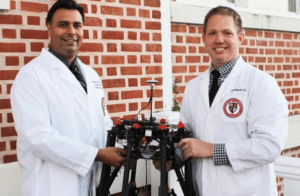
As the value of drones as life-saving devices grows, pioneers like Italo Subbarao want to open up the skies to more medical and rescue robots.
This past week, Subbarao, a senior associate dean at William Carey University College of Osteopathic Medicine, unveiled a what could be the next drone hero (or make that HiRO) – the Health integrated Rescue Operations.
Also known as the Telemedical Drone Project, the system can integrate a virtual reality environment allowing doctors to direct medical operations via drone following disasters.
“Recent catastrophic events illustrate the challenges of getting life-saving treatment to disaster victims, particularly when first responders can’t get there quickly by ground,” Subbarao said in a press release. “Our goal, as osteopathic physicians, is to bridge that delay by delivering rapid treatment directly to the victims, using remote physicians to instruct anyone on site.”
In addition to a multi-sensor quadcopter rig, HiRO includes:
- Augmented reality interface utilizing a Microsoft HoloLens headset, allowing a remote physician the ability to treat multiple victims.
- Automated medicine bins borne by the drone which empower a doctor to unlock specific compartments. “This lets bystanders get medications and equipment, supported by video guidance from the doctor,” Subbarao said.
- Integrated electronic health record systems permitting a doctor to monitor multiple patients in the field.
Subbarao and his partners are teaming up with Dennis Lott, director of a drone program at Hinds Community College in Mississippi, to design and field test HiRO.
“These drones have impressive lift and distance capability, and can be outfitted with a variety of sensors, such as infrared, to help locate victims,” Lott said. “It is just a matter of time before the drones become part of routine life.”
If successfully deployed, HiRO will join the ranks of rescue drones such as Matternet’s proposed delivery network being developed in Switzerland – the Matternet Station.
The drone hub would quickly delivery medical supplies to disaster victims as well.
Jason is a longstanding contributor to DroneLife with an avid interest in all things tech. He focuses on anti-drone technologies and the public safety sector; police, fire, and search and rescue.
Beginning his career as a journalist in 1996, Jason has since written and edited thousands of engaging news articles, blog posts, press releases and online content.
Email Jason
TWITTER:@JasonPReagan
Subscribe to DroneLife here.